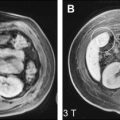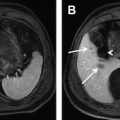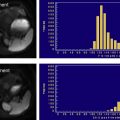Hepatic perfusion imaging with magnetic resonance (MR) imaging is an emerging technique for quantitative assessment of diffuse hepatic disease and hepatic lesion blood flow. The principal method that has been used is based on T1 dynamic contrast-enhanced MR imaging. Perfusion imaging shows promise in the assessment of tumor therapy response, staging of liver fibrosis, and evaluation of hepatocellular carcinoma. The future standardization of imaging protocols and MR imaging pulse sequences will allow for broader clinical applications.
Perfusion imaging of the liver
Perfusion imaging of the liver can be described as a quantitative imaging method reflective of hepatic parenchymal and hepatic lesion blood flow. In the realm of magnetic resonance (MR) imaging, perfusion imaging has become synonymous with dynamic contrast-enhanced (DCE) MR imaging. There are other MR imaging methods such as arterial spin labeling (ASL) that can reflect hepatic blood flow but a discussion of this technique is beyond the scope of this review. DCE MR imaging differs from the standard dynamic MR imaging performed in clinical practice in that it involves quantification of enhancement as opposed to qualitative assessment. A key requirement of perfusion imaging is a high temporal resolution (much greater than in routine DCE MR imaging), which is acquired in selected regions.
The diagnostic value of the dynamic enhancement characteristics of the background liver and liver tumor has been well recognized. Terms such as hypervascular, hypovascular, and washout are an important part of the descriptive lexicon of radiologists and play an important role in the differential diagnosis of disease. These terms reflect observations related to altered perfusion states within hepatic tumors and alterations in the balance of hepatic portal and arterial flow. Many studies have been devoted to determining the optimal timing for assessment of lesion vascularity within the constraints of imaging within a breath-hold and the typical qualitative nature of enhancement assessment remains. The lure of quantitative perfusion assessment lies in the ability to improve lesion assessment through objective measures that may be used for characterization of hepatic tumors, assessment of biologic aggressiveness, and of therapeutic response. Perfusion MR imaging indices may also represent a potential biomarker for a variety of diffuse liver diseases through detection of changes in the complex balance of arterial and venous blood flow fractions that may facilitate prognostication and timing of therapeutic intervention.
The increased interest in hepatic perfusion imaging is catalyzed by technologic improvements in MR imaging. Fast gradients have resulted in reduced scan times, and parallel imaging and partial k-space filling methods have further enabled high temporal resolution imaging. Such technological advances permit coverage of much of the liver in scan times of less than 10 seconds using two-dimensional (2D) and three-dimensional (3D) gradient echo sequences thus opening the door for pharmacokinetic analysis based on DCE MR imaging as part of a future clinical routine.
In this review, the methodologies and potential clinical applications of hepatic perfusion with MR imaging are discussed (a glossary of abbreviations is available in Table 1 ).







